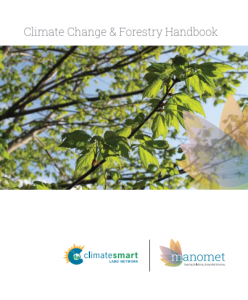 Manomet’s Climate Smart Land Network (CSLN)recently unveiled a new resource for anyone interested in understanding the science of climate change and its impacts on forests—the Climate Change & Forestry Handbook. While providing a broad overview of the topic, this book focuses particularly on changes in North America, where the majority of lands in the CSLN are located. In many ways, it is a reflection of how the CSLN has grown, not just in terms of acres (now at 33 million), but also in terms of the resources available to members.
Manomet’s Climate Smart Land Network (CSLN)recently unveiled a new resource for anyone interested in understanding the science of climate change and its impacts on forests—the Climate Change & Forestry Handbook. While providing a broad overview of the topic, this book focuses particularly on changes in North America, where the majority of lands in the CSLN are located. In many ways, it is a reflection of how the CSLN has grown, not just in terms of acres (now at 33 million), but also in terms of the resources available to members.
An important aspect of the CSLN is the distillation of the latest science into regular research bulletins for members. Over the last several years, we have developed a substantial archive of these research summaries and the Handbook now provides a one-stop shop for accessing the breadth of that information. The book is organized into three parts: (1) A Changing Climate, (2) Forest Response to Climate Change, and (3) Managing Forests in a Changing Climate. In the digital format, the Handbook also contains links pointing the reader toward the most relevant research bulletins, for those who want to delve into a particular topic in more detail.
The Handbook was originally designed as a resource for professional foresters, but Parts 1 and 2 (in particular) can be an introduction for anyone interested in understanding the science of climate change and the ways it will influence the character and composition of our forests over the long haul. Members of the CSLN now have another tool to help inform their staff about this important and complex topic, which ensures that these stewards of millions of forested acres have the information they need to prepare for climate change.
The Handbook is available online at: http://climatesmartnetwork.org/climate-resources/handbook/.





 Back to all
Back to all